| FLY RC MAGAZINEFLIGHT REPORT | by Frank Tiano |
|
This high-performance Rocket is an ideal Jet trainer! |
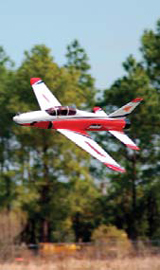 Hangar 9
Hangar 9
Jackal 50
According to Websters, a Jackal is a smart-looking, fast-moving, smoothoperating, agile and intelligent mammal capable of extraordinary feats far beyond what you might expect from something its size. After four of us took turns flying the subject of this review, all of us now realize what Mike McConville had in mind when he designed this bird and named it the Jackal.
Ill get to the performance later, but first lets talk about exactly what it is we have here. In Tiano Terms, its a rocket in a freaking box. To more sophisticated modelers, it is a finetuned honey of a bullet with wings, that doubles as an aerobatic machine whenever the pilot is inclined to get fancy. The packaging is what you have come to expect from anything that Horizon Hobby gets behind. And, it is sooo obvious they are behind this baby in a big way. Every part of this Jackal is packed in a specific place, double guarded with walls of cardboard and special cubby holes.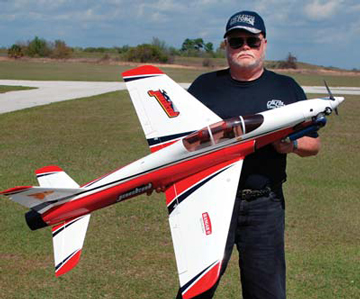 When I opened the box, I was greeted by bright colors and what appeared to be impeccable workmanship. Everything needed to complete this model is in the box, relatively speaking. The model features surfaces expertly covered in UltraCote and exquisitely painted fiberglass parts. I mean, like most other ARFs, you still need to purchase a radio, servos and engine, but this one doesnt nickel and dime you to death with hardware and special unobtanium parts not found in that local hobby shop that is now 96 miles and a $30 gas bill away.
When I opened the box, I was greeted by bright colors and what appeared to be impeccable workmanship. Everything needed to complete this model is in the box, relatively speaking. The model features surfaces expertly covered in UltraCote and exquisitely painted fiberglass parts. I mean, like most other ARFs, you still need to purchase a radio, servos and engine, but this one doesnt nickel and dime you to death with hardware and special unobtanium parts not found in that local hobby shop that is now 96 miles and a $30 gas bill away.
According to the novel-like manual, yup, I did say novel, the thing has 58 pages of information so precise with verbiage, graphics and photos that a goldfish could put it together, all you really need to buy to outfit this little ball of thunder is a 7 to 9 channel radio, servos all around, a fist full of extensions and a couple of Y harnesses. Now, you can eliminate a couple of servos, 2 extensions and a Y harness if you decide not to use the flaps. The airplane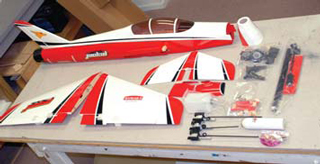 features fixed gear, but there is an optional retract package available, which I chose, and they slide right in place where the fixed package once nestled. By the way, speaking of retracting gear, you have a choice of Robarts mechanical or the pneumatics that I used. Cool.
features fixed gear, but there is an optional retract package available, which I chose, and they slide right in place where the fixed package once nestled. By the way, speaking of retracting gear, you have a choice of Robarts mechanical or the pneumatics that I used. Cool.
Fresh from the box, you can easily see the high quality and low parts count.
TIPS FOR SUCCESS
I found a heat gun and a small heat sealing tool very useful, along with normally found workshop tools. Normal, to me, means things like a ruler, pen, Dremel tool with a cutoff wheel, scissors, etc. I dont think youll find use for a 3-axis milling machine or a Sawzall. Small amounts of some adhesives are required as well; thankfully the manual suggests ZAP products, and other than a couple of toothpicks and some petroleum jelly, I think thats it.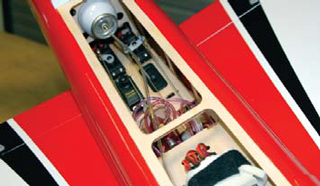
There isnt an abundance of room in the fuselage, but with a little attention to detail everything will fit well. I used the optional Robart Progressive Pneumatic Retracts.
The assembly of the Jackal 50 proceeds quite smoothly. I must admit there were a couple of steps where the written instructions didnt seem to quite match the photograph, but nothing serious, certainly nothing that a little thought and common sense didnt clear up after a few moments. The fit of the few parts that you must put together is excellent. The finish or craftsmanship, whether done by machine or hand, is really exceptional on all parts. I believe any modeler with average building skills could complete the assembly process in a maximum of 15 hours. My shop dude, John Banner, and I did it in 13.5. Remember this is a review, not a combat manual, on how to put this thing together. And with that in mind, this reviewer says there really aint much to talk about. But, notice I said much, meaning, there is some to talk about, and in this case, some means two.
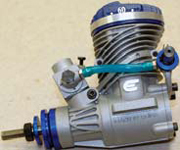
The two recommendations I have for the Jackal are just that, recommendations, and I will at least tell you why I recommend them. Whether you do what I did is entirely up to you.
The Jackal really scoots with the Evolution 60 up front.
First, on page 33 step #4, it suggests that you open up the hole in the wheels for the axles with a 3/16-inch or a 5mm drill bit. I suggest a #12 drill bit. Why? Because a 3/16 hole did not allow the axle to go through smoothly and the wheel to spin freely. It was close, but not quite. A #12 bit is another 1.5 thousandths bigger and gave just enough extra clearance to be right. A 5mm will give plenty of clearance, but I didnt have one handy and I am glad I didnt. 5mm is 0.008 bigger than the #12 and that is getting a bit looser than I like.
One other thing, I dont want to catch any of you holding the wheel and reaming out that hole the way that they show it in the manual. Hold the wheel on a block of wood and drill down into it. Even if you dont have the drill press they recommend, just pretend you do. It is mighty tough to hold a transmitter with your hand wrapped in a bandage.
|
The Jackal shows off its slow speed handling as it slows down nicely with the flaps dropped for a low and slow pass. |
In step #6 it says to place a nylon spacer on the axle before putting the wheel in place. I found that an additional spacer, or washer, was needed or the tire would rub against the strut. Again, if you dont mind the rubbing, go with one spacer. If you want to take off from grass, two is for you! And, thats it!
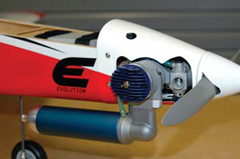
The Evo 60 in the nose makes this high performance jet-type model a readily approachable everyday flyer for the experienced pilot without the hassle or expense of a turbine.
They say hindsight is 20/20. Applying that to the Jackal 50, powered in our case by an EVO 60, I think this thing would fly great on a hot 40. After rebalancing, of course! Certainly, a 50 is fine and this EVO 60 is just perfect for the way I fly. The manual suggests either a 10×7 or 11×7 prop. While a 10×7 seems like too little prop for a 60, I see the wisdom in their recommendation. Using an 11×7 on a grass strip will cause the prop tips to green up rather rapidly because they are literally chopping grass during takeoff. The extra 1/2-inch clearance with the 10-inch prop negates that in a heartbeat. However, another recommendation from me is to lengthen the nose strut by just 1/4-inch and the whole problem becomes moot! I now use an 11×7 in comfort.
RADIO SETUP
Many modelers may not realize just how far radio technology has come. Today, you can buy a 9 channel radio with all sorts of doodads, bells and whistles, for very little more than what a 5 or 6 channel rig could have set you back 5 years ago. In our case, the JR 9503 radio was suggested for use and what a luxury it has turned out to be. Just having separate control over your flaps and ailerons is such a convenience. Those extra channels sure make setting up servo throws and travel a snap. Yes, you could fly the Jackal on a 7-channel rig, but if a new radio is in your future, give this JR 9- channel a try. Oh, and the little servos they recommend, the JR MN48s and the DS821s, are really powerful little dynamos. I would not have thought that such a small servo could produce 58 ounces of torque. More than enough, by the way, for this bird! The radio compartment of the Jackal appears to have been specifically designed for this size servo. Everything fits neatly in its own place. Nice. Page 58 of the novel tells exactly what throws and rates to dial in. Easy.
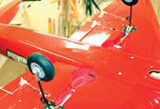 RETRACTS
RETRACTS
The Robart retracts drop right into the wing and are nearly as easy to install as a fixed gear setup.
As I mentioned above, the Jackal offers the choice of mechanical or air retracts. Hangar 9 has a unique kit of Robart gear they call the Progressive Pneumatic Tri-Gear with Air Kit that is tailored specifically for the Jackal. A Robart/Hangar 9 joint effort? I couldnt see how you could possibly go wrong with that combo, so thats what I used. For what it is worth, the progressive part of this system is based on Robarts new gear that lets you upgrade mechanical retracts to pneumatics as you desire and your budget allows.
|
Some things that may interest you: Besides being fast, it is extremely maneuverable and might be considered to be a bit touchy by some. If so, just dial back on the throws and it will tame right down. The elevator does need more down trim than called for when deploying full flaps. About 3 clicks extra will be just fine. If yours flies with a tad of up or down trim, you may have balanced it incorrectly. It flies at perfectly neutral when balanced as indicated. With full flaps, it will fly smoothly at slow speeds, just practice with it a bit. After a little time on the sticks you will be able to drag it around like a champ. All around, this is a great flying machine. My advice? If youve got the pilot experience, get one. Oh yeah, and bring lots of extra fuel, and a clean pair of shorts! |
|
PLANE: Jackal 50 MANUFACTURER: Hangar 9 DISTRIBUTOR: Horizon Hobby TYPE: High Performance Sport (Excellent Pre-Jet Trainer) FOR: Experienced Pilots WINGSPAN: 63 in. WING AREA: 496 sq. in. WEIGHT: 132 oz. (8.25 lbs.) WING LOADING: 38.3 oz./sq. ft. LENGTH: 56.75 in. RADIO: 7-9 channels required. Flown with JR 9503, Spektrum AR9000 receiver, 4 JR Sport MN-48 servos, 3 JR DS821 servos, 1 9-inch, 4 12-inch extensions, 1 24-inch extension, 2 Y-harnesses ENGINE: Evolution 60 NX PROPELLER/SPINNER: APC 10×6, 10×7, 11×7 with kit spinner TOP RPM: 13,000 to 15,000+ FUEL: Wild Cat 10% Nitro ONBOARD BATTERY: JR 4.8v 1100mAh NiCd flat pack STREET PRICE: $299 COMPONENTS NEEDED TO COMPLETE: 7-9 channel radio with accessories as above, .50 -.60 Glow engine, Retracts if desired SUMMARY: What can I say? ARFs today are just getting better and better, both in appearance and in performance! Some are better than others; some, like this one, are from another planet. This Jackal 50 has it all. There is literally nothing you, I or the ARF Fairy could improve upon. Buy it, throw it together and go kick some … ! |
CONCLUSION
So, to put it all in a tidy package, the Jackal is an inexpensive hot rod that can be flown as a sport ship. It can fly reasonably slow or brutally fast. It can be flown by anyone who has mastered a high-wing aileron model, yet it becomes most exhilarating to a pro who wants to experience the thrill of high-speed performance and full aerobatics. Hence, the Jackal. In most of my reviews, I try to find one word that comes as close as possible in describing the product. This time around the one word that best describes the Jackal is HOT !
|
APC Propellers, distributed by Landing Products, www.apcprop.com , (530) 661-0399 Evolution Engines, distributed exclusively by Horizon Hobby Distributors, www.evolutionengines.com , (800) 338-4639 Hangar 9, distributed exclusively by Horizon Hobby Distributors, www.horizonhobby.com , (800) 338-4639 JR, distributed exclusively by Horizon Hobby Distributors, www.jrradios.com , (800) 338-4639 Robart Mfg., www.robart.com , (630) 584-7616 Spektrum, distributed exclusively by Horizon Hobby Distributors, www.spektrumrc.com , (800) 338-4639 Wildcat Fuel, www.wildcatfuel.com , (859) 885-5619 ZAP and Z-Poxy, manufactured by Pacer Technology, www.zapglue.com |
 Fly RC Magazine WE LIVE RC
Fly RC Magazine WE LIVE RC
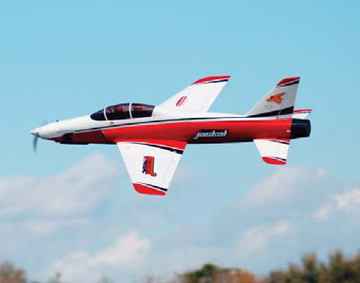 What the heck do you say, or what can you say, about an airplane that is nearly freaking perfect. I am not going to insult the intelligence of the bulk of our readers with a lame, blow by blow, description of a flight from takeoff to landing. I just cant! Simply stated, the Jackal 50 is Cool with a capital C. It is as maneuverable as you want it to be. It takes off straight as a die, tracks neutral through any maneuver the pilot is capable of putting it through once trimmed properly, has no bad tendencies and is fun to fly. Its one off the chain flying quality is that it is FAST, while remaining unchangingly stable! And, when I say fast, I mean, hair-bristling-on-your-arm, squirming-in-your-pants, drooling- on-your-shirt fast. The ole speedometer goes past 100 mph in a jiffy. And, 120 is not uncommon with an Evolution 60 on its performance muffler blazing away at 15,000+ rpm .
What the heck do you say, or what can you say, about an airplane that is nearly freaking perfect. I am not going to insult the intelligence of the bulk of our readers with a lame, blow by blow, description of a flight from takeoff to landing. I just cant! Simply stated, the Jackal 50 is Cool with a capital C. It is as maneuverable as you want it to be. It takes off straight as a die, tracks neutral through any maneuver the pilot is capable of putting it through once trimmed properly, has no bad tendencies and is fun to fly. Its one off the chain flying quality is that it is FAST, while remaining unchangingly stable! And, when I say fast, I mean, hair-bristling-on-your-arm, squirming-in-your-pants, drooling- on-your-shirt fast. The ole speedometer goes past 100 mph in a jiffy. And, 120 is not uncommon with an Evolution 60 on its performance muffler blazing away at 15,000+ rpm .